Welcome to our expert guide on addressing pool leaks in South Africa. In this comprehensive guide, you will learn effective methods for detecting, repairing, and preventing pool leaks to ensure the durability of your pool in South Africa’s unique climate. Additionally, we will cover the benefits of using automatic pool covers to help reduce water evaporation and minimize the likelihood of leaks. Our experts will share their professional tips and tricks for maintaining your pool’s structure and plumbing to prevent leaks from occurring. By following our guide, you can ensure a safe and enjoyable swimming experience for years to come. In addition to leak detection and repair, incorporating yearly pool maintenance tips south africa is essential for the long-term health of your pool. Regular maintenance not only helps identify potential issues before they escalate but also ensures your pool remains clean and inviting. By adopting these practices, you’ll enhance your pool’s performance and extend its lifespan, making it a true oasis for relaxation and enjoyment.
Key Takeaways
- Identifying signs of pool leaks is crucial for early detection and prevention.
- Confirming a pool leak can be achieved through techniques like marking the water level and conducting a bucket test.
- Locating the pool leak accurately is essential for efficient repair.
- Repairing different types of pool leaks, including skimmer leaks, light leaks, and liner leaks, requires specific methods.
- Regular pool inspections and maintenance are vital in preventing pool leaks.
Signs of Pool Leaks in South Africa
It is crucial to be able to recognize the signs of pool leaks in order to address them promptly. In South Africa, common indicators of pool leaks include wet areas around the pool, leaks at the equipment pad, and a significant decrease in water level. These signs can often go unnoticed, causing further damage and increased costs if not addressed in a timely manner. Understanding the common causes of pool leaks will help in troubleshooting and initiating the appropriate repairs.
Wet areas around the pool: If you notice puddles of water or damp spots around your pool, especially in areas that are not near the pool’s main water features, it could be a sign of a leak. Pool leaks can occur in various parts of the pool structure, including the pool shell, plumbing lines, or fittings. It is important to investigate the source of the water and address it promptly to prevent further damage.
Leaks at the equipment pad: Another common sign of pool leaks is water pooling or leaking at the equipment pad. This can indicate leaks in the plumbing lines or equipment connections. Inspecting the equipment pad regularly and checking for any visible leaks or water accumulation can help identify potential leaks early on.
Significant decrease in water level: If you notice a significant decrease in your pool’s water level over a short period of time, it is likely due to a leak. To confirm a pool leak, you can conduct a simple bucket test by filling a bucket with water and marking the water level. Place the bucket on a pool step or ledge, ensuring it is submerged to the same level as the pool water. Monitor both the bucket and pool water levels for 24-48 hours. If the pool water level drops more than the bucket water level, it indicates a leak.
Common Pool Leak Causes:
- Cracks or tears in the pool shell
- Failed or damaged plumbing lines
- Leaky fittings or connections
- Worn-out or deteriorated pool liner
- Skimmer leaks
- Light leaks
By being aware of these signs and common causes of pool leaks, pool owners in South Africa can take proactive measures to prevent further damage. Regular inspections, prompt repairs, and understanding pool plumbing basics are essential for maintaining a leak-free pool. In the next section, we will discuss techniques and tests to confirm the presence of a pool leak and accurately locate its source.

Confirming a Pool Leak – Techniques and Tests
Once you suspect a pool leak, it is important to confirm its presence through accurate testing methods. By marking the water level and conducting a bucket test, you can determine if there is a leak and narrow down its location for further investigation.
To mark the water level, use a piece of tape or a permanent marker to indicate the current water level on the inside of your pool. Check the mark after 24 hours. If the water level has significantly dropped, it is likely that you have a leak.
The bucket test involves placing a bucket filled with water on the top pool step or bench, making sure it is submerged to the same level as the pool water. Mark the water level inside the bucket and the pool water level. Leave it undisturbed for 24 hours and compare the water loss between the bucket and the pool. If the pool loses more water than the bucket, this indicates a leak.
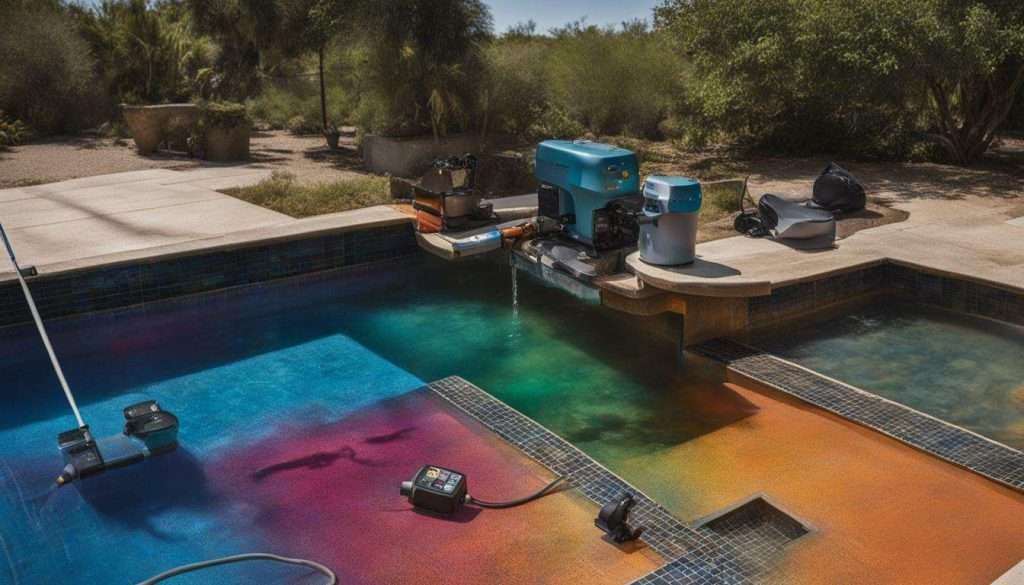
Common Signs of a Pool Leak:
- Wet areas around the pool, especially near equipment pads
- Unexplained drops in water level
- Increase in water bills
- Cracks in the pool structure
- Visible tears in the pool liner
If you suspect a leak and the tests confirm it, it is advisable to seek professional assistance from a licensed pool leak detection and repair service. They have the expertise and specialized equipment to accurately locate and repair the leak, ensuring the longevity and functionality of your pool.
| Types of Pool Leaks | Common Causes |
|---|---|
| Skimmer leaks | Cracked skimmer throat, loose or damaged skimmer basket |
| Light leaks | Worn-out gasket or faulty seal around the light fixture |
| Liner leaks | Tears or punctures in the pool liner |
“Regularly inspecting and maintaining your pool is the key to preventing and addressing pool leaks. By staying vigilant and taking prompt action, you can enjoy a leak-free pool and save on unnecessary water and repair costs.”
Locating the Pool Leak
Locating the exact source of a pool leak is crucial for effective repair. By observing where the water stops dropping, you can identify the area that requires attention. To assist you in this process, consider using a dye test solution. Add a few drops of dye near suspected areas, such as cracks or tears, and observe if the dye is quickly pulled into the leak, indicating its location.
For minor leaks, this section also provides DIY repair methods that can be attempted before seeking professional assistance. One method involves using a pool putty or an underwater epoxy to patch small holes or cracks. Simply clean the area around the leak, apply the putty or epoxy, and smooth it out to create a watertight seal. Another DIY method is using a pool liner patch kit, which includes adhesive and patches to repair tears or holes in the liner.
To summarize:
- Locate the pool leak by observing where the water stops dropping and using a dye test solution for further confirmation.
- Attempt DIY repair methods for minor leaks, such as using pool putty or epoxy, and a pool liner patch kit.
Remember, if you are unsure about the extent of the leak or unable to locate it, it is always recommended to seek the help of a licensed professional to ensure proper repair and prevent further damage to your pool.
Image:
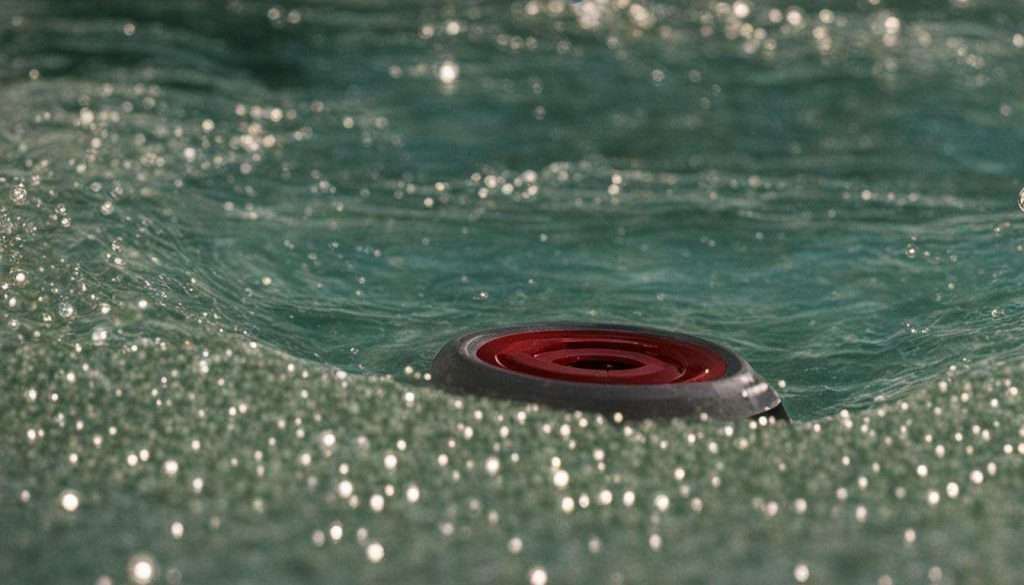
Repairing Different Types of Pool Leaks
In this section, we will guide you through the repair process for different types of pool leaks commonly encountered in South Africa. Understanding how to address skimmer leaks, light leaks, and liner leaks is essential for maintaining a leak-free pool. Regular inspections and a basic understanding of pool plumbing will greatly assist in preventing and addressing these issues.
Skimmer leaks are a common problem faced by pool owners in South Africa. To repair a skimmer leak, start by turning off the pool pump and emptying the skimmer basket. Inspect the skimmer for cracks or damage, and replace any faulty parts or seals. Apply a pool-grade silicone sealant to seal any visible cracks, ensuring a watertight seal. Allow the sealant to cure according to the manufacturer’s instructions before turning the pump back on.
Light leaks can also cause pool water loss. To address this issue, begin by turning off the power to the pool light. Remove the light fixture from the niche and inspect it for cracks or damage. Replace any faulty parts or seals, and apply a pool-grade silicone sealant to seal any visible cracks. Allow the sealant to cure before reinstalling the light fixture and restoring power.
Liner leaks can be more challenging to repair. Start by draining the pool below the level of the leak. Once the affected area is exposed, inspect the liner for tears or holes. Patch any small tears using a pool liner patch kit, following the manufacturer’s instructions carefully. For larger holes, it may be necessary to replace the damaged section of the liner. Ensure the area is clean and dry before applying a new liner patch or replacement piece. Finally, refill the pool and monitor the repaired area for any signs of further leaks.
| Type of Leak | Repair Method |
|---|---|
| Skimmer Leak | Inspect for cracks, replace faulty parts, and apply sealant |
| Light Leak | Inspect for cracks, replace faulty parts, and apply sealant |
| Liner Leak | Patch small tears or replace damaged section of the liner |
By following these repair methods, you can effectively address different types of pool leaks in South Africa. Remember, regular inspections and proper maintenance are key to preventing leaks and ensuring the longevity of your pool. If you encounter more complex leaks or are unsure about the repair process, it is advisable to seek the services of professional pool leak repair experts who can provide specialized knowledge and assistance.
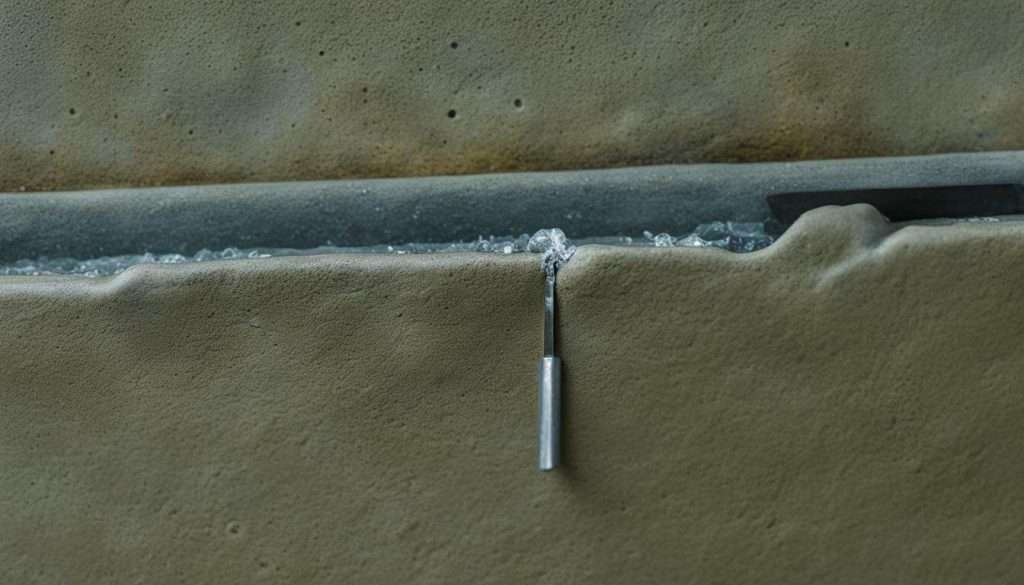
Advanced Leak Detection Methods
When traditional methods fail to locate a pool leak, advanced detection techniques can be employed. Compressed air and television cameras are powerful tools that can identify hard-to-find leaks. However, the expertise of licensed contractors is crucial when using these methods to ensure accurate detection and appropriate repairs.
The compressed air method involves pressurizing the pool plumbing system to identify leaks. By sealing all outlets, such as the skimmer, returns, and main drain, and introducing air into the system, contractors can observe bubbles or listen for hissing sounds to pinpoint the location of the leak.
Television cameras, also known as pipe inspection cameras, are another valuable tool for leak detection. These cameras are inserted into the pool plumbing system to visually inspect the pipes and identify any cracks, fractures, or other signs of damage. The live video feed allows contractors to assess the condition of the pipes and determine the extent of repairs required.
It is important to note that both compressed air and television camera methods should only be carried out by licensed contractors who are experienced in leak detection and plumbing systems. Incorrect usage of these tools can cause further damage to the pool and plumbing infrastructure, leading to more extensive repairs and increased costs.
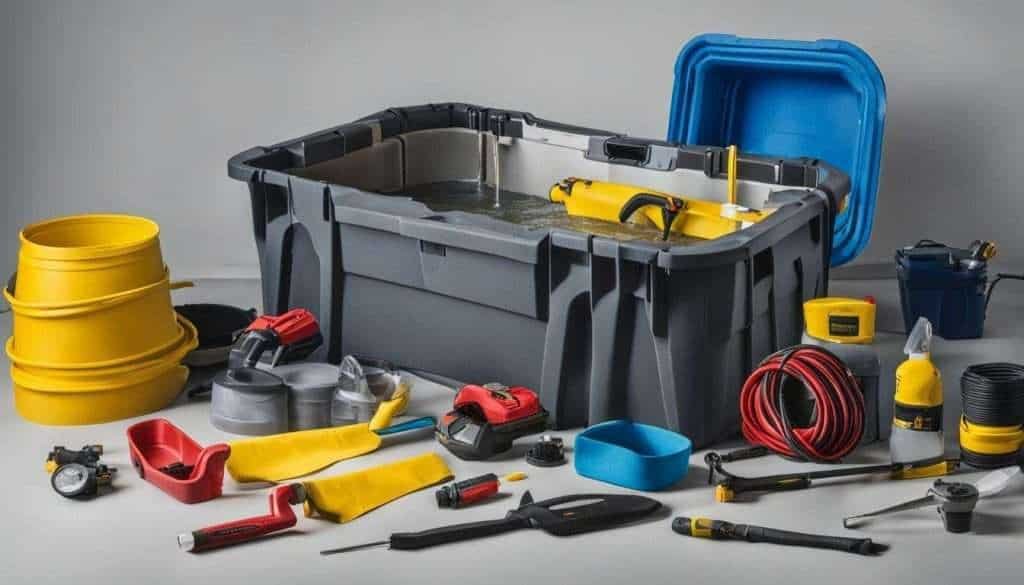
| Method | Advantages | Disadvantages |
|---|---|---|
| Compressed Air | – Effective for identifying hidden leaks – Can detect leaks in hard-to-reach areas | – Requires professional expertise – Potential risk of causing damage if not done correctly |
| Television Cameras | – Provides visual inspection of pipes – Helps determine extent of repairs | – Specialized equipment and training required – Limited to accessible areas of the plumbing system |
Importance of Regular Pool Inspections and Maintenance
Regular inspections and ongoing maintenance are key to preventing pool leaks and ensuring the long-term durability of your pool. This section will guide you through the importance of maintaining proper pool chemistry, regularly checking equipment performance, and implementing preventative measures to keep your pool leak-free.
Maintaining proper pool chemistry is essential in preventing pool leaks. It involves regularly testing and balancing the water’s pH levels, alkalinity, and chlorine content. Imbalanced chemistry can cause corrosion or deterioration of pool components, leading to leaks. By keeping the water chemistry within optimal ranges, you can protect the integrity of your pool and minimize the risk of leaks.
Another crucial aspect of preventing pool leaks is regularly checking equipment performance. This includes inspecting the pool pump, filter system, and other equipment for any signs of wear, damage, or malfunction. Faulty equipment can put unnecessary stress on the pool’s plumbing system, increasing the chances of leaks. By addressing any issues promptly and ensuring proper functioning of the equipment, you can mitigate the risk of leaks and extend the lifespan of your pool.
In addition to chemistry and equipment checks, implementing preventative measures can significantly reduce the likelihood of pool leaks. This includes installing pool covers to protect the pool from excessive evaporation and debris, securing loose tiles or grout to prevent water seepage, and sealing any cracks or gaps in the pool structure. By taking proactive steps to maintain your pool’s integrity, you can enjoy a leak-free swimming experience for years to come.
| Benefits of Regular Pool Inspections and Maintenance |
|---|
| Prevents costly repairs |
| Enhances pool longevity |
| Ensures water safety |
| Offers peace of mind |
Quote:
Regular inspections and proper maintenance are essential for maintaining the integrity of your pool and preventing leaks. By staying proactive and addressing potential issues early on, you can protect your investment and enjoy your pool for years to come.
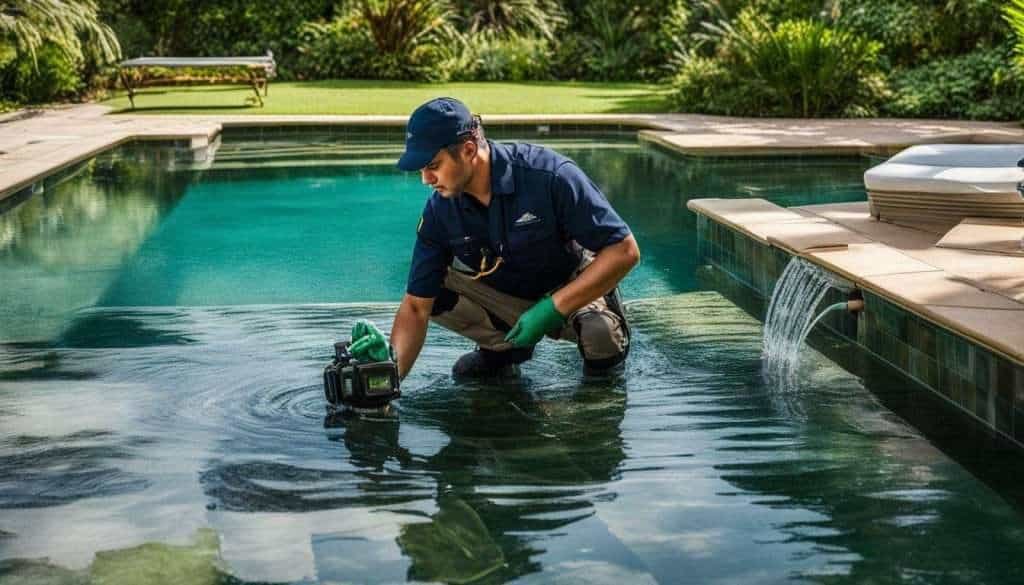
Conclusion
In conclusion, addressing pool leaks in South Africa requires proactive measures and prompt action. By understanding the signs of pool leaks, confirming their presence through testing, locating the source, and implementing appropriate repairs, you can safeguard the durability of your pool in South Africa’s unique climate. Remember to prioritize regular inspections and maintenance to prevent future leaks and ensure the enjoyment of your pool for years to come.
When it comes to addressing pool leaks, the first step is to be aware of the signs that indicate a potential problem. Look out for wet areas around the pool, leaks at the equipment pad, and any unexplained drops in water level. These can be indications of leaks that need to be addressed promptly.
Once you suspect a pool leak, it’s important to confirm its presence through testing. Marking the water level and conducting a bucket test can help you determine if there is indeed a leak. These simple techniques can provide valuable insights and guide you towards the next steps in addressing the issue.
Locating the source of the leak is crucial for effective repairs. By observing where the water stops dropping and conducting a dye test, you can pinpoint cracks or tears in the pool structure. Knowing the exact location of the leak will enable you to carry out the necessary repairs in a targeted and efficient manner.
Repairing different types of pool leaks, such as skimmer leaks, light leaks, and liner leaks, requires specific knowledge and techniques. It’s important to understand pool plumbing basics and seek professional assistance if needed. Regular inspections and maintenance are key to preventing future leaks and ensuring the long-term durability of your pool.
For advanced leak detection methods and complex repairs, it’s advisable to hire licensed contractors who specialize in pool leak detection and repair services. They have the expertise and equipment to handle intricate leaks and provide effective and reliable solutions.
By following these expert guidelines, you can address pool leaks in South Africa effectively. Don’t let leaks dampen your pool experience. Take proactive measures, detect and repair leaks promptly, and enjoy a durable and leak-free pool for years to come.
Are Pool Covers Effective in Preventing Pool Leaks?
Pool covers are highly effective in preventing pool leaks. They provide a protective layer that reduces evaporation and keeps the water sealed, preventing leaks. When considering pool cover prices, it is crucial to invest in a quality cover to ensure maximum effectiveness in protecting your pool from leaks and minimizing maintenance costs.
FAQ
How can I tell if my pool has a leak?
Some signs of a pool leak include wet areas around the pool, a constantly dropping water level, and leaks at the equipment pad. If you suspect a leak, it is important to confirm it through techniques such as marking the water level and conducting a bucket test.
How do I locate the source of a pool leak?
To locate the source of a pool leak, you can observe where the water stops dropping. This can help identify the general area of the leak. Additionally, you can use a dye test solution to identify cracks or tears in the pool structure.
What are some common types of pool leaks?
Common types of pool leaks include skimmer leaks, light leaks, and liner leaks. Each type requires specific repair methods. Regular inspections and understanding pool plumbing basics can help detect and address these leaks.
Are there advanced leak detection methods available?
Yes, there are advanced leak detection methods such as compressed air and television cameras that can be used to identify hard-to-find leaks. It is recommended to hire licensed contractors who specialize in leak detection and repair services.
How can I prevent pool leaks?
Regular pool inspections and maintenance are important in preventing pool leaks. Maintaining proper pool chemistry and monitoring equipment performance can help identify and address potential issues before they become major leaks.


